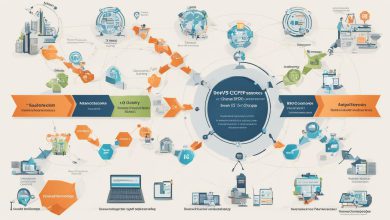
In the world of mobile app development, creating a seamless user experience is crucial. This is where mobile application architecture comes into play.
Mobile application architecture is the foundation on which the software design of a mobile app is built. It encompasses the structure and organization of an app’s codebase, along with the interrelationships between its components and layers. This architecture impacts the app’s overall performance, scalability, and security.
In this article, we will explore the basics of mobile application architecture and how it impacts app design. We will also dive into the different types of mobile app architectures and emerging trends in app development.
Key Takeaways
- Mobile application architecture is the foundation of your mobile app design.
- It impacts the app’s performance, scalability, and security.
- Understanding different types of mobile app architectures and emerging trends is crucial for successful app development.
Understanding Mobile Application Architecture
Mobile Application Architecture (MAA) refers to the process of designing and organizing the technical components and layers of a mobile application. MAA defines how the application’s software is structured and how the different modules interact with one another. A well-designed MAA ensures that the app is scalable, secure, and performs well, while also providing an excellent user experience (UX).
The MAA of a typical mobile app consists of four layers: presentation, domain, data, and infrastructure. The presentation layer is responsible for rendering the UI to the user. The domain layer contains the business logic of the application, and the data layer manages the storage of data. The infrastructure layer manages communication with external systems and services.
MAA is an essential part of the application development process. A solid architecture enables the app to handle both the current and future needs of the users. It also supports the app’s growth by allowing new features, integrations, and modules to be added without compromising performance or security.
Importance of Mobile App Architecture
Mobile app architecture plays a critical role in app development. A well-designed architecture can significantly enhance app performance, scalability, and security. It also ensures that the development process is efficient, resulting in a high-quality end product. On the other hand, a poorly designed architecture can lead to performance issues, inconsistent user experience, and app crashes. Therefore, it is essential to prioritize mobile app architecture in the development process.
Mobile app architecture impacts every aspect of the development process, from implementation to testing. A solid architecture minimizes errors, reduces development time, and ensures the best user experience. It also provides a clear framework for developers to work within, allowing for better cross-team collaboration, improved product quality, and more efficient maintenance.
Good mobile app architecture enables developers to focus on specific areas of the app independently, allowing for better module organization and task allocation. It also leaves room for future development and updates, increasing the app’s longevity.
Benefits of an effective mobile app architecture
Having an effective mobile app architecture has many benefits, including:
- Scalability – An architecture that can handle increased user load without affecting performance.
- Reliability – An architecture that ensures consistent app performance and minimizes crashes.
- Security – An architecture that provides secure data storage and transmission, protecting user information.
- Flexibility – An architecture that is easily adaptable to changing requirements or updates.
- Usability – An architecture that prioritizes user experience and provides an intuitive interface.
Therefore, it is vital to invest time and resources in developing a comprehensive and effective mobile app architecture.
Types of Mobile App Architectures
Mobile app architecture defines the structural design of an application, including its components, layers, and technologies. Different types of mobile app architectures have emerged over the years, each with its own unique set of characteristics and use cases. Here we will explore some of the most popular mobile app architectures in use today.
Client-Server Architecture
The client-server architecture is one of the most common mobile application architectures in use today. In this architecture, the client (mobile app) and server communicate with each other over a network. The client sends requests to the server, and the server responds with the requested data. This type of architecture is used in many popular mobile apps like Facebook and Twitter.
In this type of architecture, the client and server are developed separately, which allows for greater flexibility and scalability. The client and server can be updated separately, without affecting each other. This type of architecture also allows for better security, as sensitive data can be stored on the server instead of the client device.
Microservices Architecture
Microservices architecture is a newer approach to mobile app architecture that focuses on developing applications as a suite of small, independent services that communicate with each other over a network. Each microservice is responsible for a specific task, and the overall functionality of the app is achieved by combining these microservices.
This type of architecture is highly scalable and flexible, as each microservice can be developed and deployed independently. It also allows for better fault tolerance, as a failure in one microservice does not necessarily impact the entire app. Some popular apps that use microservices architecture include Netflix and Uber.
Event-driven Architecture
Event-driven architecture is a mobile app architecture that is based on the concept of events. In this architecture, the app is designed to respond to events that occur in the system, such as user actions or changes in data. When an event occurs, the app triggers a corresponding action.
This type of architecture is highly scalable and resilient, as the app can respond to a large number of events without affecting performance. It is also flexible, as the app can be easily extended with new features by simply adding new event handlers. Some popular apps that use event-driven architecture include Slack and Trello.
Each of these mobile app architectures has its own strengths and weaknesses, and the choice of architecture depends on the specific requirements and goals of the project. Developers need to carefully consider the trade-offs between scalability, flexibility, and performance when selecting an architecture for their mobile app.
Latest Trends in Mobile App Architecture
As technology continues to evolve, so does the architecture of mobile applications. In this section, we will explore the latest trends and advancements in mobile app architecture that developers and designers should be aware of.
Modular Architecture
The rise of modular architecture is transforming the way mobile apps are built and deployed. This approach involves breaking down an app into smaller, independent modules that can be developed, tested, and updated separately, resulting in a more scalable and flexible architecture. It also allows developers to add new features and functionality to an app without having to rebuild the entire application.
Serverless Architecture
Serverless architecture is another emerging trend in mobile app development. This approach involves writing code that runs on third-party servers, rather than on servers managed by the app developer. This architecture allows developers to reduce infrastructure costs and achieve greater scalability and flexibility.
Low-Code Development
Low-code development platforms are gaining popularity in the mobile app development industry. These platforms allow developers to create mobile apps using drag-and-drop interfaces, pre-built templates, and pre-configured components, significantly reducing the amount of coding required. This trend enables faster deployment and frees up developers’ time to focus on more complex problems.
These emerging trends and advancements in mobile app architecture are changing the landscape of app development. As developers and designers continue to explore new approaches and technologies, we can expect to see even more innovative mobile applications in the future.
Principles of Effective Mobile App Design
Mobile application architecture plays a crucial role in designing an effective mobile app. However, it is equally important to consider the fundamental principles of mobile app design to align with the app’s architecture. Here are some essential principles to consider:
- Usability: A well-designed app should be easy and intuitive to use. The user interface should be simple and straightforward, allowing users to navigate the app with ease.
- Scalability: A good mobile app design should be scalable and able to handle growth. As the app grows and more users begin to use it, the architecture should be able to accommodate the additional load.
- Security: An effective mobile app must be secure to protect user data. The app should be designed with security in mind, incorporating encryption and other security features to keep user data safe.
- Performance: The app should be designed to perform well across different devices and network conditions. It should load quickly and respond to user input without lag.
By keeping these principles in mind, developers and designers can create mobile apps that are user-friendly, scalable, secure, and perform well. These principles align with a solid mobile application architecture, ensuring a seamless user experience and a successful app design.
Best Practices for Mobile App Architecture
Designing a solid mobile app architecture is critical for the success of your app development. Here are some best practices to help you create an effective and efficient application architecture.
Separate Concerns
Separating concerns is a critical principle in software architecture, and it’s just as important in mobile app architecture. By separating concerns, you can make sure that each module or component of your application architecture is responsible for performing only one function. This improves the overall quality and structure of your app design.
Modularization
Modularization is another important best practice. By breaking down your app architecture into smaller modules, you can make each module more manageable and easier to maintain. This approach also makes it easier to scale your app and implement changes without affecting the entire application.
Data Management
Effective data management is essential in mobile app architecture. You need to ensure that your app’s data strategy is optimized for performance, security, and scalability. Use a well-thought-out data management strategy to ensure your app’s data is handled efficiently and securely throughout its lifecycle.
Performance Optimization
Optimizing your app’s performance is vital for delivering a quality user experience. Implementing performance optimization best practices like caching, lazy loading, and data compression can help improve your app’s speed and responsiveness.
Testing and Maintenance
Ensure that you have a robust testing and maintenance strategy in place for your application architecture. Regularly perform testing and maintenance to identify and fix issues before they become significant problems that affect the user experience.
Following these best practices can help you design a solid and effective mobile app architecture that delivers a quality user experience. By prioritizing performance, scalability, and security, you’ll be able to create a successful mobile application that meets your users’ needs while also achieving your business goals.
Future of Mobile Application Architecture
Mobile application architecture is an ever-evolving field, with new advancements and innovations emerging at a rapid pace. As technology continues to progress, the future of app design will certainly be shaped by mobile architecture improvements. Let’s take a look at some of the latest trends and emerging technologies in mobile app architecture and development.
Blockchain Technology
Blockchain technology has been a hot topic in recent years, with many industries exploring its potential applications. In the context of mobile app development, blockchain can be used to create secure decentralized apps (Dapps) without relying on a central authority. With the increasing importance of data privacy and security, blockchain technology is likely to play a significant role in shaping the future of mobile app architecture.
Artificial Intelligence (AI)
AI-powered apps are becoming increasingly popular and are expected to continue to gain traction in the future. AI can be leveraged to add new features such as voice recognition, facial recognition, and natural language processing. As mobile devices become more powerful, AI is likely to play an even more significant role in shaping the future of mobile app architecture and development.
Edge Computing
With the rise of the Internet of Things (IoT) and the increasing number of connected devices, Edge computing is another trend that is likely to impact the future of mobile app architecture. Edge computing involves processing data on devices instead of relying on a central server, improving response times and reducing network congestion. With the growing demand for faster and more efficient mobile apps, edge computing is expected to become increasingly important in the coming years.
- These are just a few examples of emerging technologies that are likely to shape the future of mobile app architecture, but there are many other advancements to keep an eye on as well.
Conclusion
Mobile application architecture is a critical component of app design. As we have explored in this article, a well-designed architecture is essential for successful app development and can have a significant impact on user experience. By understanding the components and layers of mobile app architecture, app developers can create apps that are scalable, secure, and performant.
As technology continues to evolve, we can expect to see new trends and innovations in mobile application architecture. Developers must stay up-to-date with these advancements to design apps that meet the ever-changing demands of users.
When it comes to app design, the principles of usability, scalability, security, and performance are crucial. By following best practices like separation of concerns, modularization, and data management, developers can create effective mobile app architectures that align with these principles.
As we enter the future of mobile application architecture, we can expect to see exciting developments like blockchain, AI, and edge computing. By staying informed and embracing these trends, developers can create apps that are truly innovative and groundbreaking.
In conclusion, mobile application architecture is a vital aspect of app design. By prioritizing a solid architecture and following best practices, developers can create apps that provide a seamless experience for users. As you embark on your mobile app development journey, remember to keep these principles in mind to create apps that stand the test of time.
FAQ
Q: What is mobile application architecture?
A: Mobile application architecture refers to the design and structure of a mobile app. It includes the components, layers, and patterns that make up the app’s overall framework.
Q: Why is mobile application architecture important?
A: Mobile application architecture is crucial for successful app development as it ensures scalability, performance, and maintainability. It also helps in creating a smooth user experience.
Q: What are the types of mobile app architectures?
A: There are different types of mobile app architectures, including client-server architecture, microservices architecture, and event-driven architecture.
Q: What are the latest trends in mobile app architecture?
A: Some of the latest trends in mobile app architecture include modular architecture, serverless architecture, and the rise of low-code development.
Q: What are the principles of effective mobile app design?
A: Effective mobile app design principles include usability, scalability, security, and performance considerations that align with a solid application architecture.
Q: What are the best practices for mobile app architecture?
A: Best practices for mobile app architecture include separation of concerns, modularization, and efficient data management.
Q: What is the future of mobile application architecture?
A: The future of mobile application architecture includes emerging technologies like blockchain, AI, and edge computing that will shape the future of app design.
Q: What should I take away from this article?
A: This article emphasizes the importance of mobile application architecture and provides insights into various aspects of app design. It aims to help you understand the significance of a well-designed architecture in creating successful mobile apps.








